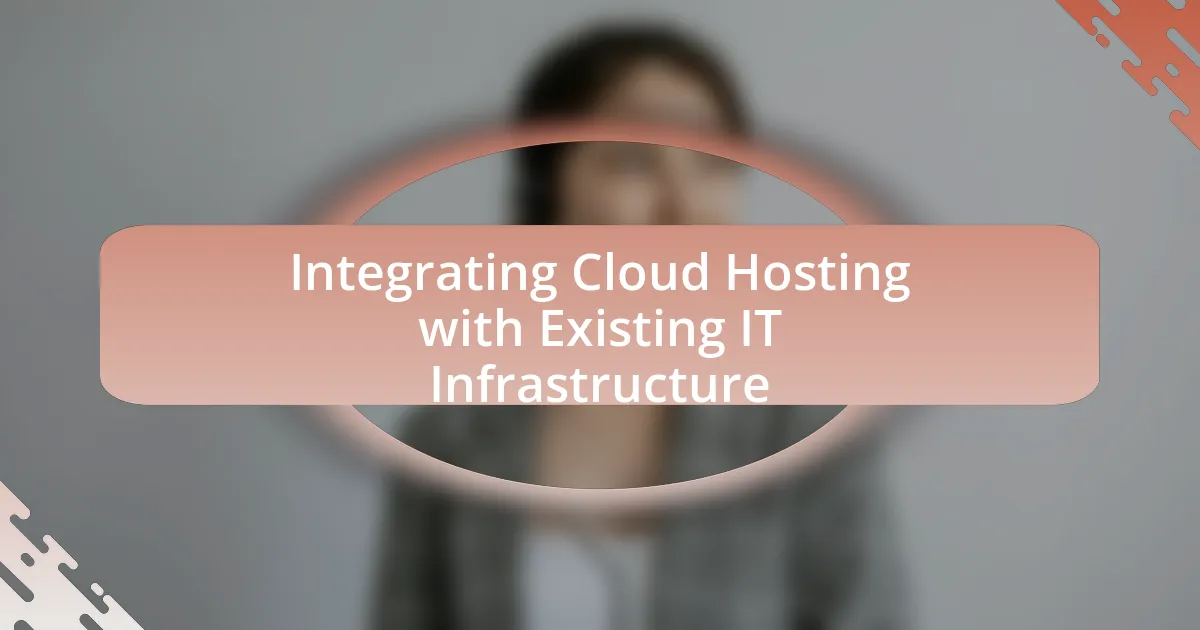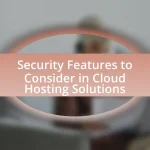Integrating cloud hosting with existing IT infrastructure involves the seamless connection between cloud services and on-premises systems, allowing organizations to enhance scalability, cost efficiency, and operational agility. Key components of this integration include hybrid cloud architectures, APIs, and security protocols, which facilitate data exchange and resource sharing. The article explores the benefits of cloud integration, such as improved collaboration and security, while also addressing challenges like data compatibility and security vulnerabilities. Additionally, it outlines best practices for successful integration, including thorough planning, stakeholder engagement, and ongoing support, as well as future trends in cloud hosting integration driven by emerging technologies like AI and automation.

What is Integrating Cloud Hosting with Existing IT Infrastructure?
Integrating cloud hosting with existing IT infrastructure involves the seamless connection and collaboration between cloud services and on-premises systems. This integration allows organizations to leverage the scalability and flexibility of cloud resources while maintaining their current IT investments. For instance, businesses can utilize cloud storage for data backup while keeping critical applications on local servers, thus optimizing performance and cost. According to a report by Gartner, 81% of enterprises have a multi-cloud strategy, indicating a trend towards integrating cloud solutions with traditional infrastructure to enhance operational efficiency and agility.
How does cloud hosting integrate with traditional IT systems?
Cloud hosting integrates with traditional IT systems through hybrid cloud architectures, enabling seamless data exchange and resource sharing. This integration allows organizations to leverage existing on-premises infrastructure while utilizing cloud resources for scalability and flexibility. For instance, businesses can maintain critical applications on local servers while offloading less sensitive workloads to the cloud, thus optimizing performance and cost. Additionally, APIs and middleware facilitate communication between cloud services and traditional systems, ensuring interoperability and streamlined operations. This approach is validated by industry reports indicating that 70% of enterprises adopt hybrid cloud strategies to enhance their IT capabilities.
What are the key components of cloud hosting integration?
The key components of cloud hosting integration include cloud service models, APIs, data migration strategies, security protocols, and monitoring tools. Cloud service models, such as Infrastructure as a Service (IaaS) and Platform as a Service (PaaS), define the resources and services available for integration. APIs facilitate communication between cloud services and existing systems, enabling seamless data exchange. Data migration strategies ensure that data is transferred efficiently and securely from on-premises systems to the cloud. Security protocols, including encryption and access controls, protect sensitive information during and after integration. Monitoring tools provide insights into performance and resource usage, ensuring that the integrated systems function optimally. These components collectively enable organizations to effectively integrate cloud hosting with their existing IT infrastructure.
How do existing IT infrastructures adapt to cloud hosting?
Existing IT infrastructures adapt to cloud hosting by implementing hybrid cloud models, which allow for the integration of on-premises resources with cloud services. This adaptation involves assessing current workloads, identifying which applications can be migrated to the cloud, and ensuring compatibility with cloud environments. For instance, organizations often utilize cloud management platforms to facilitate seamless data transfer and application integration, thereby enhancing operational efficiency. According to a report by Gartner, 81% of enterprises have adopted a multi-cloud strategy, indicating a significant trend towards integrating existing infrastructures with cloud solutions.
What are the primary benefits of integrating cloud hosting?
The primary benefits of integrating cloud hosting include enhanced scalability, cost efficiency, improved collaboration, and increased security. Scalability allows businesses to adjust resources based on demand, enabling them to handle varying workloads without significant upfront investment. Cost efficiency is achieved through a pay-as-you-go model, which reduces the need for extensive hardware and maintenance costs. Improved collaboration is facilitated by cloud hosting, as teams can access and share data in real-time from any location, enhancing productivity. Additionally, increased security measures, such as data encryption and regular backups, are often provided by cloud service providers, ensuring that sensitive information is protected against breaches. These benefits collectively contribute to a more agile and resilient IT infrastructure.
How does cloud hosting enhance scalability for businesses?
Cloud hosting enhances scalability for businesses by providing on-demand resources that can be adjusted based on fluctuating needs. This flexibility allows companies to quickly scale up or down their computing power, storage, and bandwidth without the need for significant upfront investments in physical infrastructure. For instance, a study by Gartner indicates that businesses utilizing cloud services can reduce their IT costs by up to 30% while improving their ability to respond to market changes. This capability is particularly beneficial during peak times or rapid growth phases, enabling businesses to maintain performance and efficiency.
What cost savings can be achieved through integration?
Integration can achieve significant cost savings by reducing operational expenses, minimizing redundancy, and optimizing resource utilization. For instance, organizations that integrate cloud hosting with existing IT infrastructure can lower their hardware costs by up to 30% due to decreased need for on-premises servers and maintenance. Additionally, streamlined processes can lead to a reduction in labor costs, as automation and improved workflows enhance productivity. A study by Gartner indicates that businesses can save an average of 15% on IT costs through effective integration strategies, highlighting the financial benefits of adopting a cohesive cloud and IT infrastructure approach.
What challenges might arise during the integration process?
Challenges during the integration process of cloud hosting with existing IT infrastructure include data compatibility issues, security vulnerabilities, and potential downtime. Data compatibility issues arise when existing systems and cloud services use different formats or protocols, complicating data transfer and synchronization. Security vulnerabilities can emerge due to the increased attack surface when integrating cloud services, necessitating robust security measures to protect sensitive information. Additionally, potential downtime may occur during the transition, impacting business operations and user access. These challenges highlight the need for careful planning and execution to ensure a smooth integration process.
How can data security concerns be addressed?
Data security concerns can be addressed by implementing robust encryption protocols, access controls, and regular security audits. Encryption protects data both in transit and at rest, ensuring that unauthorized users cannot access sensitive information. Access controls limit data access to authorized personnel only, reducing the risk of internal breaches. Regular security audits help identify vulnerabilities and ensure compliance with industry standards, such as the General Data Protection Regulation (GDPR), which mandates strict data protection measures. These strategies collectively enhance the security posture of cloud-hosted data within existing IT infrastructures.
What compatibility issues may occur with legacy systems?
Compatibility issues with legacy systems often arise due to outdated technology, which can hinder integration with modern cloud hosting solutions. These issues include differences in data formats, communication protocols, and software dependencies that legacy systems may not support. For instance, legacy systems might utilize proprietary data formats that are incompatible with contemporary cloud applications, leading to data migration challenges. Additionally, older systems may rely on outdated communication protocols, making it difficult to establish seamless connections with cloud services. Furthermore, software dependencies on specific hardware or operating systems can restrict the ability to leverage cloud-based resources effectively. These factors collectively complicate the integration process and can result in increased costs and extended timelines for organizations attempting to modernize their IT infrastructure.
How can organizations prepare for cloud hosting integration?
Organizations can prepare for cloud hosting integration by conducting a thorough assessment of their existing IT infrastructure and identifying the specific needs and goals for cloud adoption. This assessment should include evaluating current hardware, software, and network capabilities to ensure compatibility with cloud services. Additionally, organizations should develop a clear migration strategy that outlines the steps for transitioning to the cloud, including timelines, resource allocation, and risk management plans.
Research indicates that 83% of enterprise workloads will be in the cloud by 2025, highlighting the importance of strategic planning in cloud integration (Gartner, 2022). Furthermore, organizations should invest in training for their IT staff to ensure they possess the necessary skills to manage cloud environments effectively. By following these steps, organizations can facilitate a smoother transition to cloud hosting and maximize the benefits of cloud technology.
What strategies can facilitate a smooth transition to cloud hosting?
To facilitate a smooth transition to cloud hosting, organizations should implement a phased migration strategy. This approach allows for gradual integration of cloud services, minimizing disruptions to existing IT infrastructure. By conducting a thorough assessment of current systems and identifying which applications are suitable for cloud migration, organizations can prioritize their transition efforts effectively.
Additionally, establishing clear communication channels among stakeholders ensures that all team members are informed and aligned throughout the process. Utilizing cloud migration tools and services can also streamline the transition, providing automated solutions for data transfer and application deployment. According to a report by Gartner, organizations that adopt a structured migration plan experience 30% fewer disruptions compared to those that do not.

What are the best practices for successful integration?
The best practices for successful integration of cloud hosting with existing IT infrastructure include thorough planning, clear communication, and continuous monitoring. Thorough planning involves assessing current infrastructure capabilities and identifying gaps that cloud solutions can fill, ensuring alignment with business objectives. Clear communication among stakeholders facilitates understanding of integration goals and expectations, which is crucial for collaboration. Continuous monitoring of the integration process allows for timely adjustments and optimization, ensuring that performance metrics are met and potential issues are addressed promptly. These practices are supported by industry reports indicating that organizations with structured integration strategies experience up to 30% faster deployment times and improved operational efficiency.
How can organizations assess their readiness for cloud integration?
Organizations can assess their readiness for cloud integration by conducting a comprehensive evaluation of their current IT infrastructure, processes, and workforce capabilities. This assessment typically involves analyzing existing hardware and software compatibility, evaluating data security and compliance requirements, and identifying gaps in skills or knowledge among staff. For instance, a survey by Gartner indicates that 70% of organizations face challenges in cloud adoption due to insufficient skills, highlighting the importance of workforce readiness. Additionally, organizations should perform a cost-benefit analysis to understand the financial implications of cloud integration, ensuring alignment with business objectives.
What tools can assist in evaluating existing IT infrastructure?
Tools that can assist in evaluating existing IT infrastructure include network monitoring software, performance management tools, and IT asset management systems. Network monitoring software, such as SolarWinds or Nagios, provides real-time insights into network performance and identifies bottlenecks. Performance management tools like New Relic or AppDynamics analyze application performance and user experience, helping to pinpoint areas for improvement. IT asset management systems, such as ServiceNow or Lansweeper, track hardware and software assets, ensuring compliance and optimizing resource allocation. These tools collectively enable organizations to assess their IT infrastructure effectively, leading to informed decisions regarding upgrades and integrations with cloud hosting solutions.
How can stakeholder engagement improve integration outcomes?
Stakeholder engagement can significantly improve integration outcomes by ensuring that the needs and concerns of all parties involved are addressed throughout the integration process. Engaging stakeholders fosters collaboration, leading to a clearer understanding of requirements and expectations, which minimizes the risk of misalignment between cloud hosting solutions and existing IT infrastructure. For instance, a study by the Project Management Institute found that projects with high stakeholder engagement are 20% more likely to succeed, highlighting the importance of inclusive communication and feedback mechanisms. This proactive approach not only enhances user acceptance but also facilitates smoother transitions and reduces operational disruptions during integration.
What role does training play in the integration process?
Training is essential in the integration process as it equips employees with the necessary skills and knowledge to effectively utilize new cloud technologies alongside existing IT infrastructure. By providing targeted training programs, organizations can ensure that staff understand the functionalities and benefits of cloud solutions, which enhances their ability to integrate these systems seamlessly. Research indicates that companies that invest in comprehensive training during technology transitions experience a 30% increase in productivity and a 25% reduction in integration-related errors, demonstrating the critical impact of training on successful integration outcomes.
How can staff be effectively trained for cloud technologies?
Staff can be effectively trained for cloud technologies through a structured approach that includes hands-on experience, formal training programs, and continuous learning opportunities. Implementing practical workshops allows staff to engage directly with cloud platforms, enhancing their understanding of real-world applications. Formal training programs, such as those offered by cloud service providers like AWS and Microsoft Azure, provide foundational knowledge and certifications that validate skills. Continuous learning can be fostered through online courses, webinars, and access to resources like documentation and community forums, ensuring that staff stay updated with the latest advancements in cloud technologies. According to a report by Gartner, organizations that invest in comprehensive training programs see a 30% increase in employee productivity and a significant reduction in cloud-related errors.
What ongoing support is necessary post-integration?
Ongoing support necessary post-integration includes regular system monitoring, performance optimization, and user training. System monitoring ensures that the integrated cloud hosting and existing IT infrastructure operate smoothly, identifying and resolving issues proactively. Performance optimization involves adjusting resources and configurations based on usage patterns to maintain efficiency and cost-effectiveness. User training is essential to ensure that staff can effectively utilize the new system, which enhances productivity and reduces errors. These support elements are critical for maintaining operational continuity and maximizing the benefits of the integration.

What are the future trends in cloud hosting integration?
Future trends in cloud hosting integration include increased adoption of hybrid cloud environments, enhanced automation through AI and machine learning, and a focus on security and compliance. Hybrid cloud environments allow organizations to combine on-premises infrastructure with public cloud services, providing flexibility and scalability. Automation tools powered by AI and machine learning streamline deployment and management processes, reducing operational costs and improving efficiency. Additionally, as data privacy regulations become more stringent, businesses are prioritizing security measures and compliance frameworks to protect sensitive information in cloud environments. These trends are supported by industry reports indicating that hybrid cloud adoption is expected to grow significantly, with a projected market size of $97.64 billion by 2023, according to a report by MarketsandMarkets.
How is the landscape of cloud hosting evolving?
The landscape of cloud hosting is evolving towards greater hybrid and multi-cloud solutions, enabling organizations to integrate cloud services with their existing IT infrastructure more seamlessly. This shift is driven by the need for flexibility, scalability, and cost-effectiveness, as businesses increasingly adopt a mix of public, private, and on-premises resources to optimize their operations. According to a report by Gartner, by 2025, 85% of organizations will adopt a cloud-first principle, indicating a significant trend towards prioritizing cloud solutions in IT strategies. This evolution is further supported by advancements in technologies such as containerization and orchestration, which facilitate the deployment and management of applications across diverse environments.
What emerging technologies are influencing cloud integration?
Emerging technologies influencing cloud integration include artificial intelligence (AI), machine learning (ML), serverless computing, and edge computing. AI and ML enhance cloud integration by automating processes and improving data analysis, enabling organizations to make informed decisions quickly. Serverless computing allows developers to build applications without managing server infrastructure, streamlining deployment and scaling. Edge computing processes data closer to the source, reducing latency and improving performance for cloud applications. These technologies collectively enhance the efficiency, scalability, and responsiveness of cloud integration efforts.
How will AI and automation impact cloud hosting strategies?
AI and automation will significantly enhance cloud hosting strategies by optimizing resource allocation, improving scalability, and increasing operational efficiency. These technologies enable predictive analytics, allowing cloud providers to anticipate demand and adjust resources dynamically, which leads to cost savings and improved performance. For instance, a study by Gartner indicates that organizations utilizing AI-driven automation can reduce cloud infrastructure costs by up to 30% while enhancing service delivery. This integration of AI and automation into cloud hosting not only streamlines management processes but also facilitates better security measures through automated threat detection and response, ultimately transforming how businesses leverage cloud services.
What practical tips can ensure successful integration of cloud hosting?
Successful integration of cloud hosting requires careful planning and execution. First, assess your current IT infrastructure to identify compatibility and integration points with cloud services. This involves evaluating existing applications, data storage needs, and network capabilities. Next, choose a cloud service provider that aligns with your business requirements, ensuring they offer the necessary features, security, and compliance standards. Implement a phased migration strategy to minimize disruptions, starting with non-critical applications before moving to core systems. Additionally, establish clear communication and training for your team to facilitate the transition and address any challenges. Regularly monitor performance and security post-integration to ensure the cloud environment meets operational expectations. These steps are supported by industry best practices, which emphasize the importance of thorough assessment, strategic planning, and ongoing management in achieving successful cloud integration.


